Cancers Treatable with Proton Therapy
Using the latest technology, proton therapy can be used to treat 80% of all cancer types.
HOW PROTONS KILL CANCER
Protons damage both cancerous cells and healthy cells in the same way. They damage the DNA by ionizing it, taking away electrons to balance the positively charged protons. Healthy cells can recover whereas cancer cells do not due to their instability. Spreading out the treatments (in my case, 5 per week for almost eight weeks) allows healing to take place in surrounding tissue.
Suppose both cancerous and healthy cells start at level ten (a fictitious measurement I have made up for illustrative purposes). Proton treatment reduces all the tissues to six. The healthy cells bounce back to ten but the cancer cells only to nine. After the next treatment, the healthy cells recover to ten again, but the cancer cells only to eight. After the next treatment, the healthy cells go back to ten but the cancer cells only to seven. The cancer reaches a threshold level below which it can no longer recover or reproduce. The healthy tissue returns to normal.
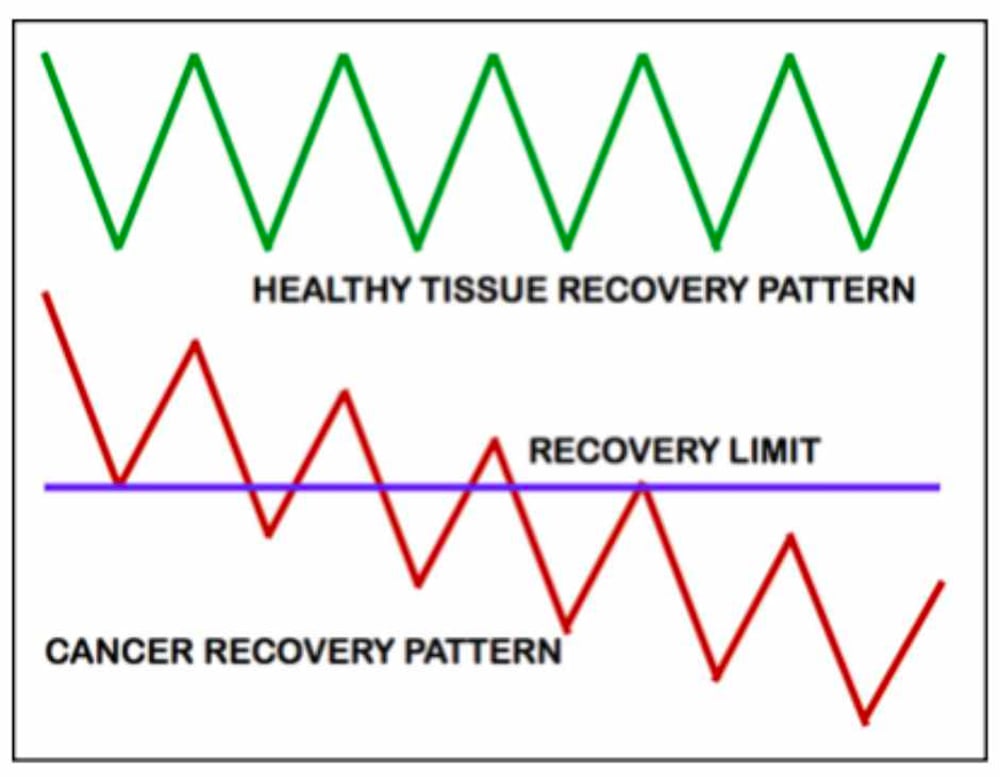
I made the above diagram to summarize the recovery process of both types of cells. What it doesn’t show is time. The destruction of the cancer cells continues over time, long after the proton treatment ends.
I have read that can effectively disable cancer cells and thus prevent their reproduction by causing physical damage the DNA. Remember that protons have mass, whereas x-rays do not. To the DNA, protons are like wrecking balls. Several studies have shown that protons cause a double-strand break and x-rays only a single strand break.
This article entitled “Proton beam radiation induces DNA damage and cell apoptosis in glioma stem cells through reactive oxygen species” describes how proton therapy does a better job than x-rays (photons) in destroying both single and double strand of DNA in such a way as to prevent the body from repairing them. See:
https://www.ncbi.nlm.nih.gov/pmc/articles/PMC4564801/)
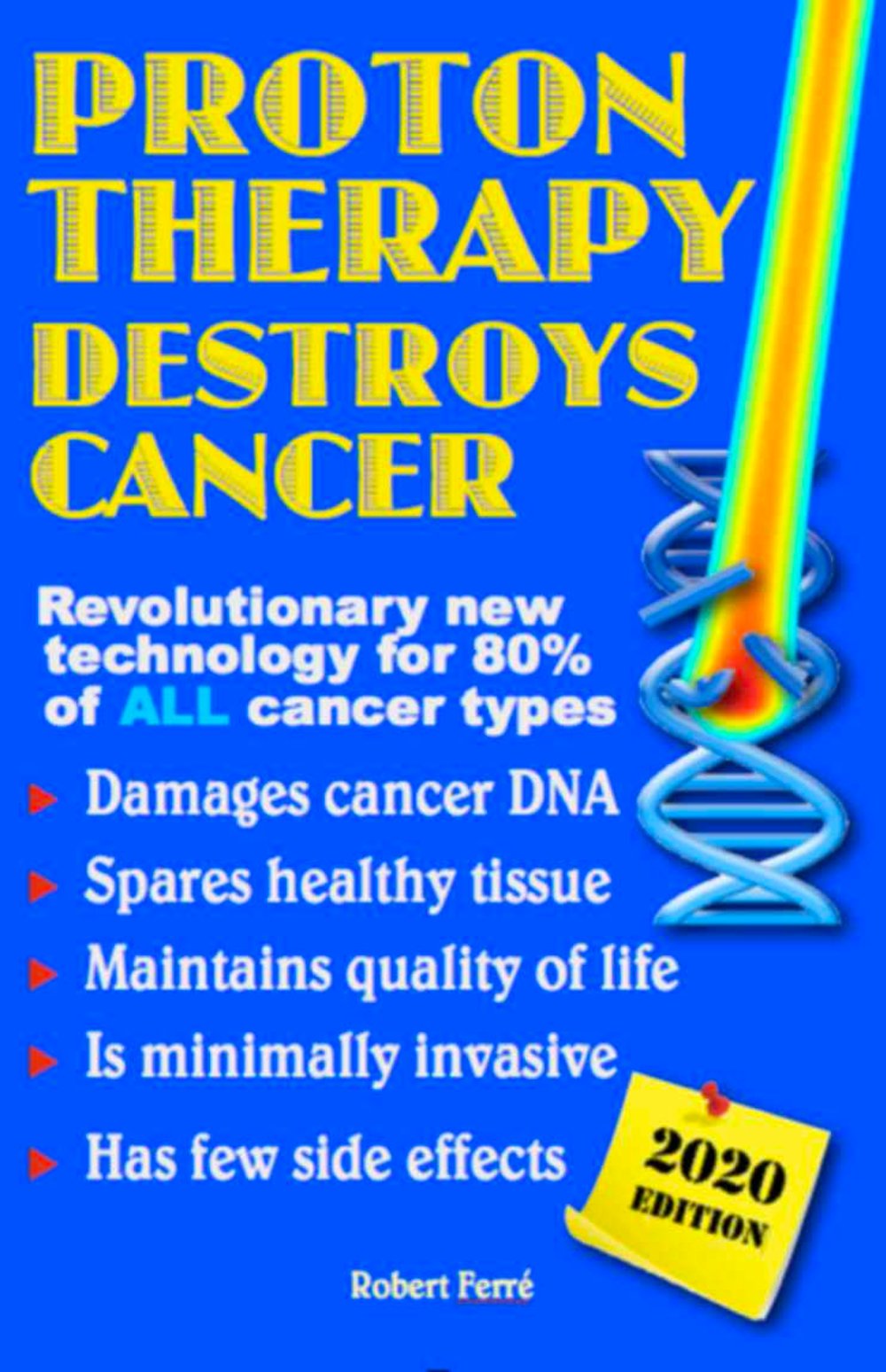
Above: I have pictured the cancer DNA being damaged by protons.
Technological advances in proton therapy have led to its ability to treat 80% of all cancers. To be effective, proton therapy requires a specific target. So systemic cancers, such as leukemia, would not qualify. The benefits of proton therapy pertain to all cancer types. Foremost, is its accuracy and conformal capability, allowing it to treat cancers very close to important organs that excess radiation would damage.
Proton therapy is strongly established as the appropriate modality for pediatric cancers in the brain, for example. Radiation can cause long-term problems for young, growing bodies. Accuracy is of the utmost importance. Dr. Anita Mahajan, medical director at MD Anderson Proton Therapy Center in Houston treated a teenage girl with a skull base chordoma. She says this. “The location of her tumor, nestled between the brain stem and spinal cord, was a deciding factor in using IMPT.” (IMPT stands for Intensity Modified Proton Therapy, an advanced form of pencil beam scanning.)
Another advantage of proton therapy is the fact that the protons release their energy in the target and then stop (see: PHYSICS). Historically, for example, radiation for breast cancer has accepted damage to the lungs and heart as part of the cost of stopping the cancer. Because they stop dead (pun intended) protons can hit the tumor and spare the surrounding organs. This is true for all treatable cancers.
Proton therapy can handle multiple targets. Because pencil beam scanning “paints” the target in layers and rows of overlapping dots, it can be very specific. The example I like to give is that of a jar filled with red and white marbles.

Pencil beam scanning could treat all the red marbles while sparing the white marbles (or vice versa), as long as each one can be identified and located precisely. Location and identification have been enhanced with improvements of scanning. This is especially true for PSMA scans in prostate cancer (see EXPERIENCE). See also the essay on future developments (see FUTURE).
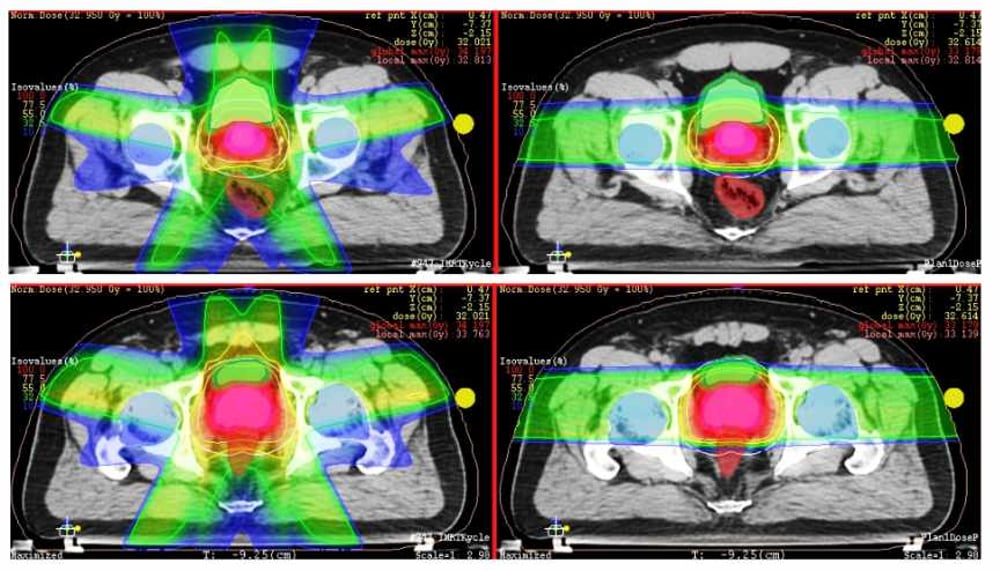
Above: X-rays, shown on the left, would affect far more healthy tissue than protons, shown on the right. This example is for prostate cancer, but this is true for all cancers. The term “conformal” relates to precision in matching the shape and location of the tumor. Because protons are applied in a series of layers and rows, they are truly three-dimensional, matching the contour of the target. X-rays seek conformity by coming from many directions.
In my book, Proton Therapy Destroys Cancer (see: BOOKS), I include details about the following cancers (not an exhaustive list) briefly summarized here:
Base of skull
Brain tumors
The Oklahoma Proton Therapy Center lists these as among the brain tumors best suited for proton therapy.
Low-grade glioma
Recurrent glioma
Meningioma
Pituitary adenoma
Craniopharyngioma
I gave a talk about proton therapy attended by a friend who had developed brain cancer. He went to MD Anderson in Houston, where he received treatment with X-rays that damaged his brain and left him with serious cognitive impairment. They have a proton therapy center at MD Anderson, which could have avoided that result. He asked me after the talk why they hadn’t treated his brain cancer with protons. My guess is that his family doctor didn’t know about proton therapy and referred him to a radiologist who specialized in X-rays. He wanted the business, treated my friend, and never mentioned protons. Cynical? Unethical? It happens all the time. That’s why cancer patients must be proactive.
Breast Cancer
This three-minute video tells the story of one woman with breast cancer who chose proton therapy.
https://www.youtube.com/watch?v=bF4wCECEnYI.
My wife Ruth Hanna died of breast cancer in 2007 after being tortured with surgery, chemotherapy and radiation. There were only three proton therapy centers then. Despite my research, I never found them. Perhaps she could still have been alive today rather than dying at the age of 62. I dedicated my proton therapy book to her.
Esophageal cancer
One consideration in cancer treatment is the likelihood of secondary cancer, caused by the radiation from the original cancer. The MD Anderson Clinic in Houston calculated for esophageal cancer, X-rays have a whopping 96% additional cancer risk. I know someone treated twice for esophageal cancer, the first time with x-rays, which was horrible and debilitating with a long recovery time, and the second time with proton therapy, after which she could swallow easily and returned to work in a week.
Gastrointestinal cancer
The proton therapy center at MD Anderson in Houston lists these as the gastrointestinal cancers they treat with proton therapy:
Anal cancer
Bile duct cancer
Esophageal cancer
Gastric cancer
Metastatic tumors
Pancreatic cancer
Primary liver cancer
Rectal cancer
This doctor has a message for other doctors:
https://www.youtube.com/watch?v=zQFWQCh10lk.
Head and Neck Cancers
A feeding tube is less frequently required with protons. Proton therapy better preserves neurocognitive function, vision, swallowing, hearing, taste and speech. This video from the Mayo Clinic (from 2014) shows survival rates are longer for proton therapy (and that was prior to many recent improvements):
https://www.youtube.com/watch?v=1WCtOW_KOxk.
This patient with nasopharyngeal cancer tells about his experience with proton therapy: https://www.youtube.com/watch?v=z79gzjTU7jk. He talks about how it preserved his teeth, jaw, taste buds, and vision.
Hodgkin’s Lymphoma
This video show that proton therapy avoids the number one cause of death with Hodgkin’s Lymphoma, a second cancer.
https://www.youtube.com/watch?v=2qeBgULz5rI.
Liver Cancer (hepatocellular carcinoma, HCC)
Basically, this podcast (audio) attributes to proton therapy a possibility of long-term survival that didn’t exist previously.
https://www.youtube.com/watch?v=ympWpzsRXWw.
Lungs: Non-Small-Cell Lung Cancer (NSCLC)
Here is the story of one man’s journey with lung cancer:
https://www.youtube.com/watch?v=DJ6ReDB4suM.
Optical Tumors (ocular melanoma)
Because of their accessibility, shallow depth and soft tissue, eyes require very little energy behind the protons. Therefore, the first proton therapy centers to open to the public used equipment that produced only low energy protons, suitable solely for optical purposes. According to this video, proton beam therapy is associated with the lowest overall risk of local tumor recurrence in uveal melanoma, compared with other eye-conserving forms of primary treatment.
https://www.ncbi.nlm.nih.gov/pubmed/27558251
Oropharynx cancer
Our results suggest that IMPT (protons) is associated with reduced rates of feeding tube dependency and severe weight loss without jeopardizing outcome.
This conclusion comes from the article “Intensity modulated proton beam therapy (IMPT) versus Intensity modulated photon therapy (IMRT = X-rays) for oropharynx cancer patients—a case matched analysis.” Full article:
https://www.ncbi.nlm.nih.gov/pmc/articles/PMC5474304/
Pancreatic Cancer (Adenocarcinoma of the pancreas)
The proton therapy center in Seattle states these goals for treating this deadly cancer:
1. Target the tumor only
2. Protect your liver, stomach, kidneys, small intestine and spinal cord
3. Maintain your quality of life during pancreatic and bile duct cancer treatment
4. 4. 4.Reduce side effects of treatment, including nausea, vomiting, heartburn, cramping, malabsorption (inability to absorb nutrients from food), diarrhea and dehydration
5. Lower the risk of secondary cancer caused by radiation
Pediatric Cancers
Here is a link to the celebrated story of Ashya King, whose parents abducted him from a British hospital and fled to Spain, where authorities arrested them for their efforts to see that he received proton therapy for his brain cancer. This is a classic case of fighting the establishment to get the best treatment for the ones you love.
https://www.dailymail.co.uk/news/article-5436163/Ashya-Kings-parents-reveal-incredible-recovery.html
In a similar situation, a couple from Belgium found their doctors advised against proton therapy, even though their own success rate was 10-15% and proton therapy was 90%.
Want more? Here is an article from the University of Pennsylvania School of Medicine:
https://www.sciencedaily.com/releases/2017/10/171023123051.htm
Pelvic Chondrosarcoma (bone cancer)
Historically, this type of bone cancer has had frighteningly grim prognosis, with limbs being amputated and cancer returning. Just look at these articles:
https://search.nih.gov/search?utf8=%E2%9C%93&affiliate=nih&query=Chondrosarcoma+(CS)+is+a+primary+malignant+bone+tumor+with+cartilaginous+differentiation.+Poor+rates+of+survival+and+high+rates+of+local+recurrence+%20after+surgical+treatment+have+been+reported+in+previous+studies.&commit=Search
I got an email from David Bowles telling me his story. Here is a little of it:
I had a large hip bone tumor for which I had been offered, by EVERY doctor I talked to except one, a 15 hour surgery which might have left me in a wheelchair for life, with major side effects (deep infection, lymphedema, etc.) to boot. I am now cancer free and totally mobile, thanks to this incredible treatment (proton therapy). . . . My doctor believes that my recovery from a cancer which had always been treated surgically might just have shown the next generation of pelvic chondrosarcoma patients a completely new path for their treatment.
That is the promise of proton therapy and why I promote it so strongly. Bowles saw ten (10!) doctors all of whom recommended surgery (the traditional option) before finding proton therapy. What an extreme difference in outcome.
Prostate Cancer
I cover this in a separate essay about my experience. See: EXPERIENCE.
Researchers at the University of Florida report that 99 percent, 94 percent and 74 percent of men with low-, intermediate-, and high-risk prostate cancer, respectively, have no signs of cancer recurrence after five years of followup. Less than one percent in the cohort experienced serious gastrointestinal side effects and approximately three percent experienced serious urologic side effects. For this and similar articles see:
https://www.floridaproton.org/about-us/research-portfolio)
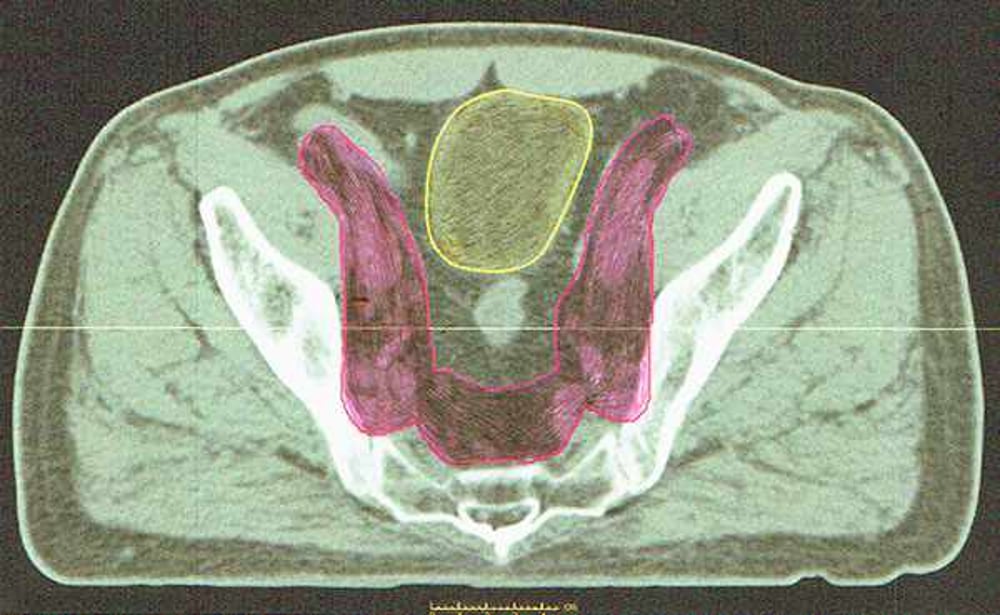
From my prostate cancer treatment, here is a picture of my lymph nodes (maroon color) that form a “U” shape around the bladder (yellow) and rectum. The large white areas are bone. Proton therapy can treat the U-shape without affecting the area in the center. X-rays go right on through.
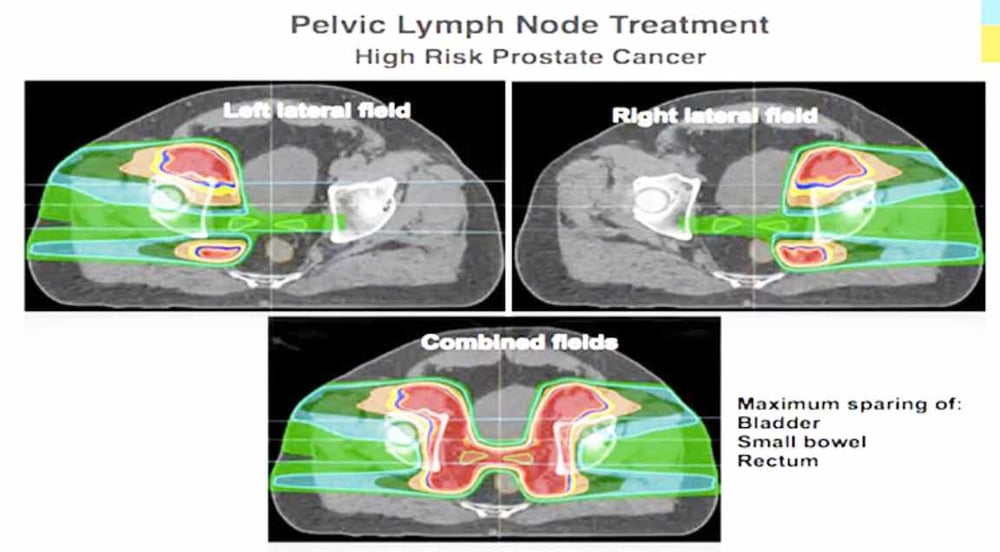
Above: A specific illustration of treating the lymph nodes.
Below: A chart pertaining to side effects of treatment. The numbers may vary from one study to another, but they are always in the same order. This one is from the proton therapy center in Prague. Surgery is the worst (on the left), photons (X-rays) are in the middle, and protons have the least effect (on the right). The three groups below illustrate impotence, incontinence, and relapse (recurrence).

In case these numbers are too hard to read, here is what they are:
Impotence: surgery 75%, photons 40%, protons 3%
Incontinence: surgery 30%, photons 5%, protons 1%
Relapse: surgery 10%, photons 8%, protons 1%
Recurrent Tumors
A study in the United Kingdom found that out of every 1,000 new cancer patients, 523 (52%) receive x-ray radiation therapy as part of their treatment. Unfortunately, out of these, 120 patients (23%) will require re-treatment. This startling number refers to all cancers.
Skin Cancer
The website for the proton therapy center in Maryland lists the types of skin cancer they treat:
Basal Cell Carcinoma
Squamous Cell Carcinoma
Melanoma
Merkel Cell Carcinoma
Kaposi Sarcoma
Sebaceous Gland Carcinoma
Here is the link to their website: https://mdproton.com/is-proton-therapy-right-for-me/can-it-treat-my-cancer/skin/
Spinal Cord Tumors (Intradural tumor)
The main spinal chord tumors are intramedullary (tumors begin in the cells within the spinal cord itself, such as gliomas, astrocytomas, or ependymomas). Extramedullary tumors include meningiomas, neurofibromas, schwannomas, and nerve sheath tumors.
****************
The above list of cancer types treatable with proton therapy is not exhaustive. For all cancers, the principles are the same: more accurate, less damage to healthy tissues, fewer side effects, better quality of life.
Not explained here is the nature of dosimetry, making sure the right dose of proton radiation reaches the right target in the right way, and continues to do that consistently. There are many safeguards and checks, known as Quality Assurance. In the essay on my personal experience with proton therapy, I describe these practices. Even though my cancer was in the prostate, the procedures pertain to other types of cancer as well.
For example, I had a custom-fitted leg cradle to keep my legs and hips in the same position for treatment. Some patients who have tumors in the head or neck wear a custom-made mask, with the same purpose. To read about my treatment, see:
EXPERIENCE
RETURN TO PROTON THERAPY PAGE
HOME PAGE